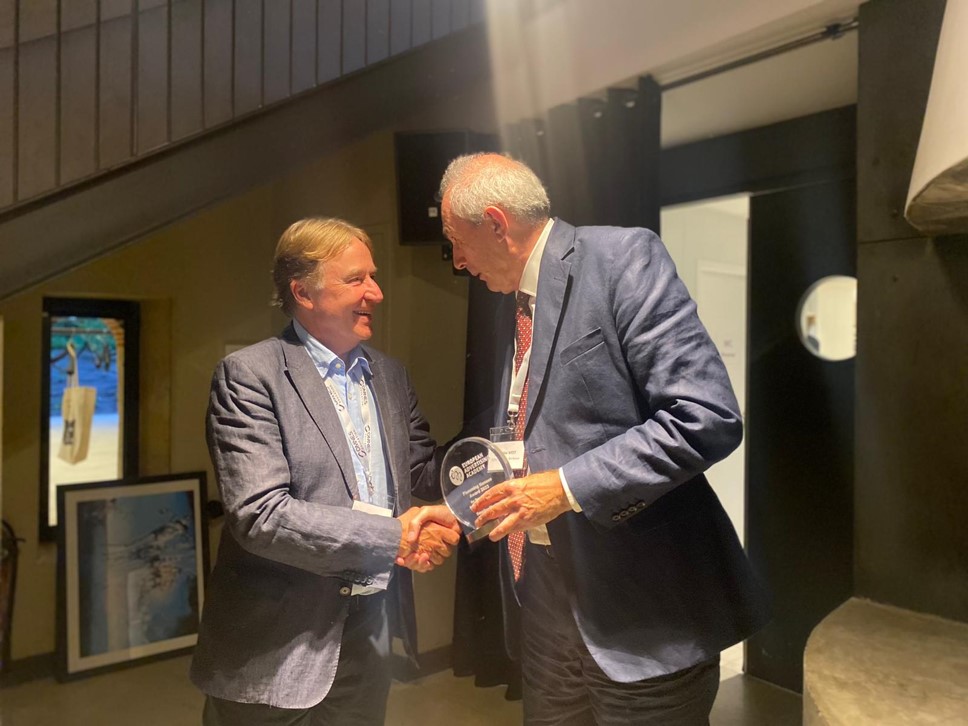By Douglas West: Life and times of a journal editor
LIFE AND TIMES OF A JOURNAL EDITOR
By Douglas West, Emeritus Professor King’s College London
Douglas West received the Flemming Hansen Award 2023 for Excellence in Advertising Research. In this short piece he outlines his time as a Journal Editor and explains how he got involved, what the experience was like. He finishes by offering some advice to reviewers and contributors on working with academic marketing journals.
I was greatly honoured to receive the Flemming Hansen Award 2023 for Excellence in Advertising Research at the International Conference on Research in Advertising (ICORIA) in Bordeaux.
I first met Prof. Hansen when Antwerp hosted ICORIA back in the late 2000s. Flemming (1938–2010) was professor of marketing at the Copenhagen Business School and founder of ICORIA. He was particularly known for his work on consumer choice and on advertising effectiveness and for his ability to bring practitioners and academics together. He and Prof. Peter Neijens (University of Amsterdam and renowned communications scholar) had approached me when I was editor of the International Journal of Advertising (IJA) about forming a link between the conference and the Journal.
I was equally keen on the idea and approached the publisher, who readily agreed. Ever since, the IJA has had strong links to ICORIA and sponsored various prizes and encouraged authors to submit their work.
Some background: In 2003, I had been asked to take on the role of editor-in-chief working alongside Colin McDonald as editor of the IJA. It was a nice title for me, but I did very little and aside from offering occasional support to Colin, who did the hard work of deciding what manuscripts to send out for blind peer review and to whom, and to make the final decision on to what to publish.
I did this for a couple of years and then took over as editor when Colin decided to pass on the baton in 2004. Along with the production team—particularly WARC’s Catherine Gardner and Matthew Coombs—we replaced the paper-based submission system to an online process and managed to secure a Social Sciences Citation Index (SSCI) listing for the Journal as part of the Web of Science index of articles.
As Peter Neijens pointed out to me at the recent Bordeaux ICORIA, moving from paper-based submissions has certainly made the process more efficient, but there was a downside that he pointed out: perhaps it has led to more reviewers rejecting taking on reviews? And I think he has a good point. In the days when a reviewer would receive a returned submission package from an academic journal, the delivery included a signed letter from an editor and a hard copy of the paper—a response that was much more personal than a computer-generated request and something less to reject compared to an easy URL link to click on.
After a five-year stint, I handed over the editorship of the IJA to Prof. Ray Taylor (Villanova University) and what a great job he has done with the Journal ever since. His in-depth research-oriented editorials are worth a read alone.
For me, it was a great relief. I now had my weekends freer and the weekly ping in my inbox of a new submission was a thing of the past. I assured my wife that my days as an editor had come to an end. I had done my bit and I could get back to focusing on research.
Then I got the phone call.
It seemed so simple: Would I help balance out a panel of four (two top academics and two top practitioners, all from the U.S.) to shortlist and interview potential editors for the Journal of Advertising Research (JAR). My role would be to provide the European perspective and to apply any experience from having edited a journal.
I still had my weekends and the pinging had stopped. I was happy to help. When the post was advertised, many fantastic applicants expressed an interest in the position. But, in each case, logistical stumbling blocks stopped us filling the post.
Another probe call: The chair of the panel saying that one of the panel members had suggested that maybe I might consider the post?
What do you say? Given the contribution of the JAR to advertising theory and practice since the 1960s, it seemed too much of an opportunity to turn down. I agreed, reluctantly reporting back to my wife that I was back to a seven-day work week, with a steady stream of pings at all hours of the day and night!
But, as smoothly as IJA had operated, JAR had got itself into somewhat of a pickle. After the esteemed Arthur Kover (Fordham and Yale School of Management) had left its top editorial post, the Journal had run through a series of editors—mostly practitioners rather than academics—and somewhere along the line the idea of a themed issues had taken hold. It meant that JAR was constantly looking at themes rather than individual papers. When a paper was submitted, it had to be judged on two criteria. No matter how strong it might have been, the first consideration was whether it fit a chosen theme. If it didn’t, then the hard-copy paper would be shelved, with an acceptance/rejection decision awaiting the opportunity for a possible fit into a future theme.
By the time I signed on, there were literally hundreds of manuscripts awaiting review. More precariously, we had so many papers queued up for consideration that we had no papers in the works after the issue after next! Working alongside my esteemed Editor in Chief Geoffrey Precourt—WARC’s Americas Editor at the time—we pondered, “What to do?”
This is where you must do the sums. There is a limited capacity to any editorial review board. Requests to review three of four papers a year is a reasonable request, but still a demanding load. Bear in mind that each manuscript needs a minimum of three reviewers, if not four. If you have 50 reviewers, their maximum capacity at any one time is say 50 divided by three, which only gets you to around 16 to 17 papers. And we still had several hundred papers languishing on the shelf.
Fortunately, I was able to call on several distinguished academics to form a small team along with their research students (particular mention here to Leyland Pitt) to supplement our formal Editorial Review Board. Having first established that the older submissions were still active, I went through the backlog of papers (many awaiting review after two to three years and one that had been on the shelf for four years!).
With the help of the team, we managed to complete reviews in record time with authors responding in a timely manner. The JAR quickly got back on track. We moved to more efficient online submissions, and the rest, as they say, is history. The high spot during my term was the privilege of overseeing the 50 years (1960-2010) anniversary issue along with our editor-in-chief, Geoffrey Precourt.
I stepped into an advisory role (hello weekends, goodbye pings). With the superb teamwork of Jenni Romaniuk and John Ford—and then John Ford alone—and now, with the newly appointed Colin Campbell, the JAR is in robust health and looking forward to the next 50 years.
What has my experience at IJA and JAR taught me about editing a journal? Perhaps key is the realisation and understanding that a journal’s reviewers are at the heart of the endeavour.
What would I ask of reviewers?
- The quality and timeliness of reviews are key to success, but my central plea to reviewers would be not to turn down requests for reviews in the absence of specialist knowledge. No journal can control what authors submit and often specialist reviewers in a topic are already committed. The editor will know it’s not your subject area, so simply start off your review stating that you will take a generalist perspective and take it from there.
- Plus, bear in mind, that one or two of the other reviewers will likely be specialists. Quality and time are the two key variables.
- One other point is not to make the review personal. Instead, always keep the review at “arm’s length” by referring to the “manuscript” (or ms) rather than first person.
What advice would I give authors?
- Understand the audience of the journal and frame the manuscript accordingly. Papers often fail at the first stage because they don’t fit. Look at your bibliography from the perspective of the topics represented. Its’ not about citing the journal concerned; rather it’s about the general domain. Case in point: The IJA is the “International Journal of Advertising” rather than the “Journal of International Advertising”. You don’t need to be doing international advertising research.
- Spell out the contribution clearly and early in the manuscript.
- Make sure that the theory, method, and analysis all match.
- It may surprise you to know that many reviewers comment on the extent to which a manuscript adheres to the journal’s style guidelines and often see it more importantly than editors might. Reviewers often see the presence or absence of following style guidelines as a proxy for the effort made in a submission.
- Journals are contracted to publishers for a set number of pages for each issue. Thus, “real estate” within all journals is scarce. Be as concise as possible.
With all that in mind, I am deeply honoured by the Flemming Hansen Award and hope and trust that this partial potted history of the IJA and JAR, and advice to reviewers and authors, will prove of value.

